Related Research Articles

The Battle of Okinawa, codenamed Operation Iceberg, was a major battle of the Pacific War fought on the island of Okinawa by United States Army (USA) and United States Marine Corps (USMC) forces against the Imperial Japanese Army (IJA). The initial invasion of Okinawa on 1 April 1945 was the largest amphibious assault in the Pacific Theater of World War II. The Kerama Islands surrounding Okinawa were preemptively captured on 26 March, (L-6) by the 77th Infantry Division. The 82-day battle lasted from 1 April until 22 June 1945. After a long campaign of island hopping, the Allies were planning to use Kadena Air Base on the large island of Okinawa as a base for Operation Downfall, the planned invasion of the Japanese home islands, 340 mi (550 km) away.

The Battle of Iwo Jima was a major battle in which the United States Marine Corps (USMC) and United States Navy (USN) landed on and eventually captured the island of Iwo Jima from the Imperial Japanese Army (IJA) during World War II. The American invasion, designated Operation Detachment, had the purpose of capturing the island with its two airfields: South Field and Central Field.
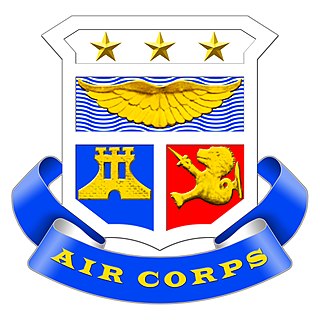
The Philippine Army Air Corps was created in 1935 as the air component of the Philippine Army. It was the predecessor of the Philippine Air Force, created in 1947.

The Far East Air Force (FEAF) was the military aviation organization of the United States Army in the Philippines just prior to and at the beginning of World War II. Formed on 16 November 1941, FEAF was the predecessor of the Fifth Air Force of the United States Army Air Forces and the United States Air Force.

Nichols Field was a U.S. military airfield located south of Manila in Pasay and Parañaque, Metro Manila, Luzon, the Philippines. The complex is located at Andrews Avenue by the north, Domestic Road by the west, NAIA Road and Ninoy Aquino Avenue by the southwest, Multinational Avenue by the south, South Luzon Expressway and the Metro Manila Skyway by the east, and Sales Street by the northeast.

The Battles of Khalkhin Gol were the decisive engagements of the undeclared Soviet–Japanese border conflicts involving the Soviet Union, Mongolia, Japan and Manchukuo in 1939. The conflict was named after the river Khalkhin Gol, which passes through the battlefield. In Japan, the decisive battle of the conflict is known as the Nomonhan Incident after Nomonhan, a nearby village on the border between Mongolia and Manchuria. The battles resulted in the defeat of the Japanese Sixth Army.

The Battle of Changsha of 1944 was an invasion of the Chinese province of Hunan by Japanese troops near the end of the Second Sino-Japanese War. As such, it encompasses three separate conflicts: an invasion of the city of Changsha and two invasions of Hengyang.
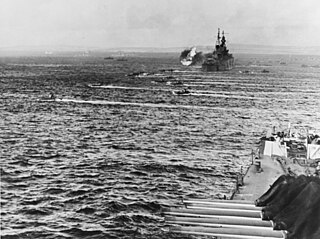
The Battle of Saipan was a battle of the Pacific campaign of World War II, fought on the island of Saipan in the Mariana Islands from 15 June to 9 July 1944 as part of Operation Forager. It has been referred to as the "Pacific D-Day" with the invasion fleet departing Pearl Harbor on 5 June 1944, the day before Operation Overlord in Europe was launched, and launching nine days after. The U.S. 2nd Marine Division, 4th Marine Division, and the Army's 27th Infantry Division, commanded by Lieutenant General Holland Smith, defeated the 43rd Infantry Division of the Imperial Japanese Army, commanded by Lieutenant General Yoshitsugu Saitō. The loss of Saipan, with the deaths of at least 29,000 troops and heavy civilian casualties, precipitated the resignation of Prime Minister of Japan Hideki Tōjō and left the Japanese archipelago within the range of United States Army Air Forces B-29 bombers.

The Battle of Guam was the American recapture of the Japanese-held island of Guam, a U.S. territory in the Mariana Islands captured by the Japanese from the United States in the First Battle of Guam in 1941 during the Pacific campaign of World War II. The battle was a critical component of Operation Forager. The recapture of Guam and the broader Mariana and Palau Islands campaign resulted in the destruction of much of Japan's naval air power and allowed the United States to establish large airbases from which it could bomb the Japanese home islands with its new strategic bomber, the Boeing B-29 Superfortress.

The Philippines campaign, also known as the Battle of the Philippines or the Fall of the Philippines, was from December 8, 1941, to May 8, 1942, the invasion of the Philippines by the Empire of Japan and the defense of the islands by United States and the Philippine Armies during World War II.

Wendell Fertig was an American civil engineer, in the American-administered Commonwealth of the Philippines, who organized and commanded an American-Filipino guerrilla force on the Japanese-occupied, southern Philippine island of Mindanao during World War II. Fertig's widely scattered guerrilla force numbered approximately 32,000. He faced about 50,000 Japanese soldiers, mostly garrison troops in towns and cities.
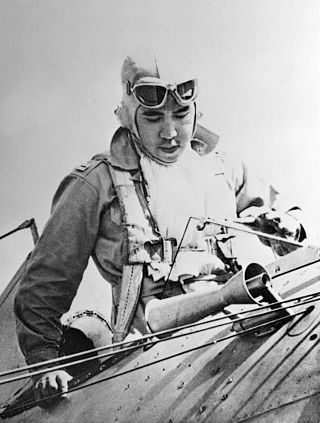
Jesús Antonio Villamor was a Filipino-American pilot who fought the Japanese in World War II.
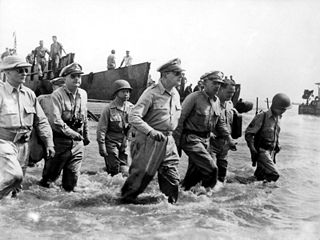
The Philippines campaign, Battle of the Philippines, Second Philippines campaign, or the Liberation of the Philippines, codenamed Operation Musketeer I, II, and III, was the American, Mexican, Australian and Filipino campaign to defeat and expel the Imperial Japanese forces occupying the Philippines during World War II.
Kibeikibei was a term often used in the 1940s to describe Japanese Americans born in the United States who returned to America after receiving their education in Japan. Some Japanese Americans sent their children, many of whom had dual citizenship, back to Japan, so the children were educated in Japanese school systems and maintained the Japanese language as well as Japanese cultural traditions. Another reason was the strong anti-Japanese sentiment in the United States and these parents worried that they might be deported back to Japan. As a result, they sent their children to Japan, so they could survive either in the United States or Japan. The exact number is not known—perhaps about 11,000. It is said there were about 10,000 Kibei among Nisei (second-generation) Japanese Americans.

Minoru Sasaki sometimes referred to as Noburo Sasaki, was a Lieutenant General in the Imperial Japanese Army during World War II.
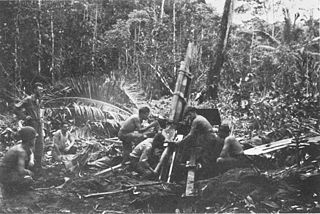
The Battle of Wickham Anchorage took place during the New Georgia campaign in the Solomon Islands during the Pacific War from 30 June – 3 July 1943. During the operation US Marines and US Army troops landed by ship around Oleana Bay on Vangunu Island and advanced overland towards the anchorage where they attacked a garrison of Imperial Japanese Navy and Army troops. The purpose of the attack by the U.S. was to secure the lines of communication and supply between Allied forces involved in the New Georgia campaign and Allied bases in the southern Solomons. The U.S. forces were successful in driving the Japanese garrison from the area and securing the anchorage, which would later be used to stage landing craft for subsequent operations.
The Battle of Maguindanao or Cotabato and Maguindanao Campaign was one of the final battles of the Philippines Campaign of World War II. The battle was fought in advance of U.S. landings by Philippine Commonwealth military forces and the recognized Christian and Muslim guerrilla fighters against Imperial Japanese Army troops.
Jose Protacio Cangco Gozar was a Filipino military aviator and a flight officer of the Philippine Army Air Corps, who was awarded at the outbreak of World War II the Distinguished Service Cross.
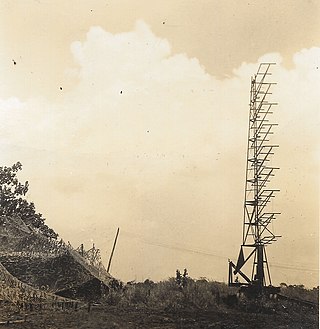
The Marine Corps Early Warning Detachment, Guadalcanal (1942–43) was a ground based early-warning radar detachment that provided long range detection and rudimentary fighter direction against Japanese air raids during the Battle of Guadalcanal. Initially deployed as part of the headquarters of Marine Aircraft Group 23, this detachment established an SCR-270 long range radar that allowed the Cactus Air Force to husband its critically short fighter assets during the early stages of the battle when control of the island was still very much in doubt. The detachment arrived on Guadalcanal on August 28, 1942, began operating in mid-September, and did not depart until early March 1943. Combat lessons learned from this detachment had a great deal of influence on the Marine Corps' development of its own organic, large scale air warning program which began in early 1943.

The Raid on Yontan was an Empire of Japan military operation carried out on the night of May 24-25, 1945 against Yontan Airfield on Okinawa. The airfield had been recently seized by American forces during the first day of the Battle of Okinawa and was being used by United States Marine Corps and Army Air Force squadrons. Five Imperial Japanese Army Mitsubishi Ki-21 bombers, carrying Giretsu Kuteitai special airborne attack troops, conducted a suicide raid against Kadena and Yontan airfields on Okinawa. Four were shot down, but the fifth belly landed on the principal runway at Yontan allowing 10-12 giretsu troops to disembark on the airfield. The raid resulted in the destruction or damaging of 38 American aircraft and 70,000 gallons of fuel however its overall value was minimal because Yontan Airfield was reopened at 0800 the following morning with little effect to overall allied aviation operations.
References
- ↑ Merriam Press, "Japanese Officer Led a U.S. Air Strike Against His Own Troops" (retrieved on August 30th, 2011).
- ↑ Life magazine, "Japanese Defector" (retrieved on August 30th, 2011).
- ↑ Merriam Press, "Japanese Officer Led a U.S. Air Strike Against His Own Troops" (retrieved on August 30th, 2011).
- ↑ Titusville Herald, "Captured Jap Officer Shows Targets to Marine Flyers" (retrieved on August 30th, 2011).
- ↑ Merriam Press, "Japanese Officer Led a U.S. Air Strike Against His Own Troops" (retrieved on August 30th, 2011).